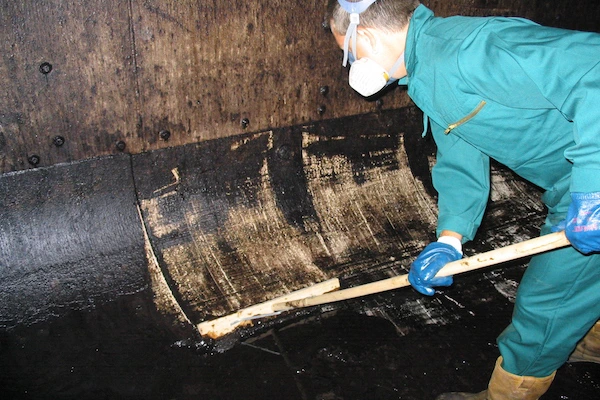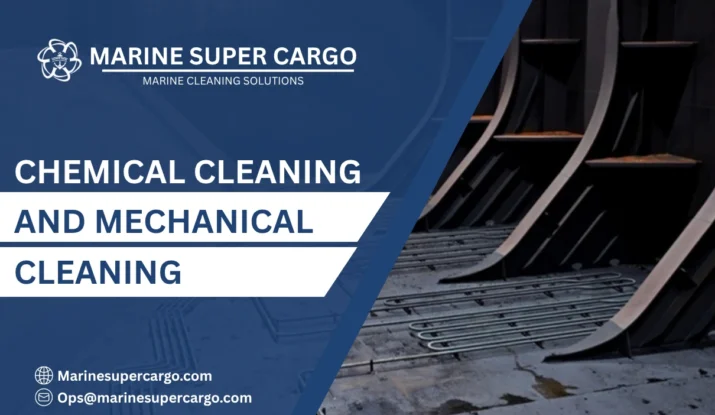Understanding Chemical Cleaning and Mechanical Cleaning Methods
Chemical cleaning and mechanical cleaning represent two fundamental approaches to tank maintenance aboard marine vessels. Each method offers distinct advantages depending on cargo residues, tank conditions, and operational requirements. Selecting between chemical cleaning and mechanical cleaning determines operation efficiency, cost-effectiveness, and environmental impact.
Marine Super Cargo provides expertise in both chemical cleaning and mechanical cleaning applications. Our comprehensive approach helps operators select appropriate methods complying with MARPOL and IMO regulations while achieving superior cleaning results.
What is Chemical Cleaning?
Chemical cleaning employs purpose-formulated products that break down cargo residues through chemical reactions. Chemical cleaning agents include alkaline cleaners, acidic solutions, solvents, and biodegradable detergents selected based on residue composition. During chemical cleaning, products circulate throughout tanks, penetrating deposits and dissolving them for easy removal.
Chemical cleaning requires careful agent selection ensuring compatibility with tank coatings and previous cargo types. Wrong chemical cleaning products may damage protective coatings or create hazardous reactions. Marine Super Cargo maintains extensive chemical cleaning compatibility databases guiding safe product selection.

What is Mechanical Cleaning?
Mechanical cleaning removes residues through physical action without chemical agents. Mechanical cleaning methods include high-pressure water jetting using tank cleaning machines, manual scraping with hand tools, and abrasive blasting for heavy scale removal. Mechanical cleaning relies on kinetic energy dislodging deposits from surfaces.
The mechanical cleaning approach proves environmentally friendly since it avoids introducing chemical agents into marine environments. Mechanical cleaning generates only physical waste—removed residues and wash water—simplifying disposal compared to chemical cleaning and mechanical cleaning waste streams containing reactive substances.
When to Choose Chemical Cleaning
Persistent Organic Residues
Chemical cleaning excels removing organic deposits like vegetable oils, animal fats, and polymerized petroleum products. These residues resist mechanical cleaning but dissolve readily under appropriate chemical cleaning agents. Chemical cleaning proves essential when switching from fatty cargo to clean products requiring residue-free tanks.
Scale and Mineral Deposits
Chemical cleaning effectively removes mineral scale, rust, and calcium deposits accumulating on tank surfaces. Acidic chemical cleaning and mechanical cleaning solutions dissolve these inorganic compounds while mechanical cleaning merely dislodges surface layers leaving embedded deposits. Chemical cleaning achieves thorough descaling impossible through mechanical cleaning alone.
Pre-Survey Preparation
Chemical cleaning often precedes tank surveys requiring pristine conditions. Chemical cleaning combined with mechanical cleaning delivers inspection-ready surfaces meeting classification society standards. The chemical cleaning and mechanical cleaning process removes staining and discoloration enhancing defect visibility during inspections.
Temperature-Sensitive Operations
Chemical cleaning operates effectively at ambient temperatures unlike mechanical cleaning often requiring heated wash water. When heating systems fail or fuel economy matters, chemical cleaning provides viable alternatives. Chemical cleaning and mechanical cleaning also suits tanks where elevated temperatures might damage coatings or cargo residues.
When to Choose Mechanical Cleaning
Heavy Sludge Removal
Mechanical cleaning proves superior for heavy sludge, sediments, and thick deposits. High-pressure mechanical cleaning jets cut through accumulated layers more efficiently than chemical cleaning dissolution. Mechanical cleaning physically flushes material from tanks rather than waiting for chemical cleaning and mechanical cleaning reactions.
Routine Cargo Switching
When switching between compatible petroleum products, mechanical cleaning using hot water washing suffices. Chemical cleaning becomes unnecessary expense for routine operations. Mechanical cleaning maintains operational tempo while achieving adequate cleanliness per cargo tank specifications.
Environmental Sensitivity
Mechanical cleaning minimizes environmental impact since wash water contains only cargo residues without added chemical cleaning agents. When discharging to port reception facilities with restrictions on chemical cleaning waste, mechanical cleaning proves preferable. Mechanical cleaning aligns with MARPOL Annex I environmental protection objectives.
Cost Considerations
Mechanical cleaning typically costs less than chemical cleaning operations. While chemical cleaning agents add significant expense, mechanical cleaning requires only water, heating fuel, and equipment maintenance. For budget-conscious operations, mechanical cleaning delivers acceptable results economically.
Combining Chemical Cleaning and Mechanical Cleaning
Sequential Application
Many operations benefit from combining chemical cleaning and mechanical cleaning sequentially. Apply chemical cleaning first, allowing agents to soften deposits. Follow with mechanical cleaning physically removing loosened residues. This combined approach achieves superior results exceeding either chemical cleaning or mechanical cleaning alone.
Targeted Applications
Use chemical cleaning for problem areas while employing mechanical cleaning for general surfaces. Spot-treat persistent stains with chemical cleaning products while mechanical cleaning handles bulk residue removal. This targeted combination optimizes both chemical cleaning efficiency and mechanical cleaning productivity.
Survey and Repair Preparation
Major tank surveys require both chemical cleaning and mechanical cleaning. Initial mechanical cleaning removes gross contamination. Chemical cleaning follows, dissolving remaining residues and staining. Final mechanical cleaning rinses away chemical cleaning products delivering inspection-ready conditions.
Safety Considerations for Both Methods
Chemical Cleaning Hazards
Chemical cleaning introduces reactive substances requiring careful handling. Chemical cleaning agents may be corrosive, toxic, or flammable. Proper enclosed space entry protocols protect personnel during chemical cleaning operations. Ensure adequate ventilation when working with chemical cleaning products within tanks.
Mechanical Cleaning Risks
Mechanical cleaning presents different hazards including high-pressure equipment injuries and slips from wet surfaces. Secure all mechanical cleaning equipment preventing movement during vessel motion. Maintain proper pre-cleaning inspection procedures before mechanical cleaning operations commence.
Marine Super Cargo emphasizes safety protocols for both chemical cleaning and mechanical cleaning operations, ensuring crew protection while achieving operational objectives.
Environmental Impact Assessment
Chemical cleaning potentially impacts marine environments more significantly than mechanical cleaning. Chemical cleaning agents, even biodegradable products, affect marine life when discharged improperly. Select environmentally responsible chemical cleaning products minimizing ecological harm.
Decision-Making Framework
Evaluate several factors determining whether chemical cleaning or mechanical cleaning suits specific situations:
- Residue type and thickness
- Previous and next cargo compatibility
- Available time and operational schedule
- Budget constraints and cost considerations
- Environmental regulations and discharge restrictions
- Tank coating condition and sensitivity
- Available equipment and expertise
- Port facility capabilities
FAQs About Chemical Cleaning vs Mechanical Cleaning
Q1: Can chemical cleaning damage tank coatings?
Improperly selected chemical cleaning agents can damage coatings, but appropriate products used correctly pose no risk. Always verify chemical cleaning compatibility with coating manufacturer specifications before application to prevent damage.
Q2: Is mechanical cleaning sufficient for all cargo types?
No, mechanical cleaning alone cannot remove certain residues like polymerized oils, heavy scale, or chemical staining. These situations require chemical cleaning either exclusively or combined with mechanical cleaning for effective results.
Q3: How long does chemical cleaning take compared to mechanical cleaning?
Chemical cleaning typically requires longer duration—6-12 hours including dwell time—while mechanical cleaning often completes within 4-8 hours. However, chemical cleaning may reduce overall time by eliminating multiple mechanical cleaning cycles.
Q4: Which method costs less overall?
Mechanical cleaning generally costs less for routine operations. However, chemical cleaning may prove more economical long-term by preventing deposit buildup requiring expensive remediation. Total cost includes labor, materials, disposal, and downtime considerations.


